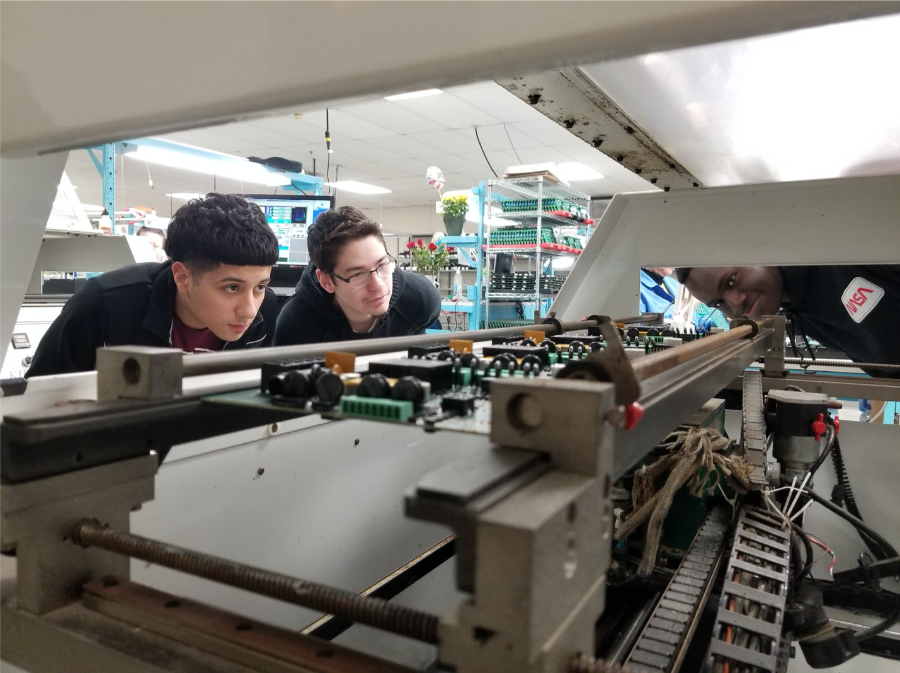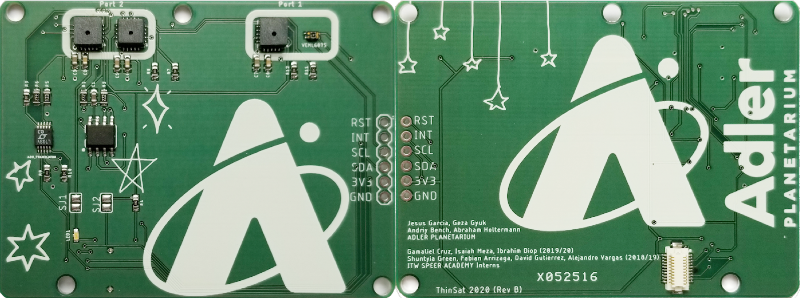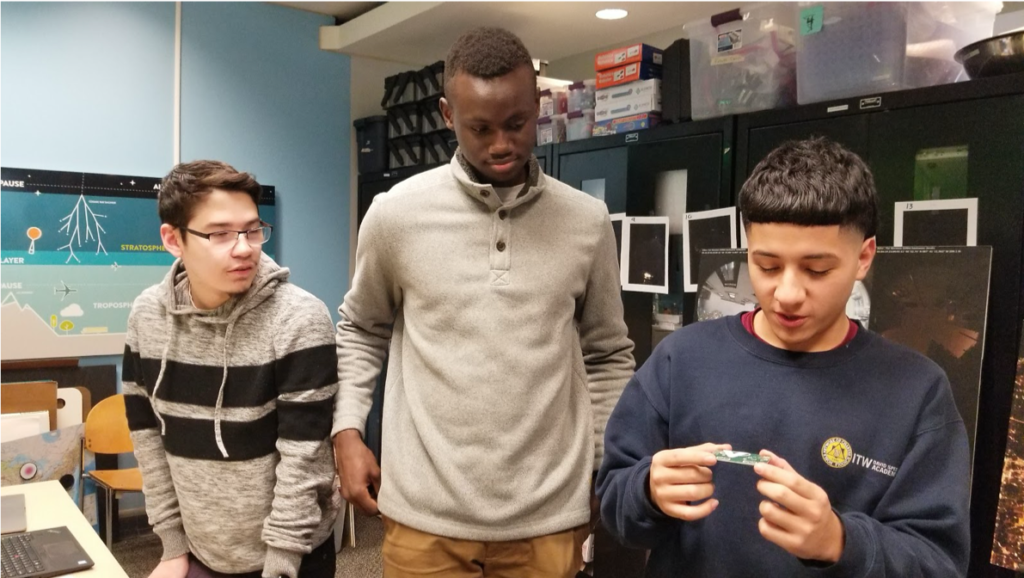Adler Teens Talk ThinSat and Working From Home

Header Image: Gamaliel Cruz (far left) alongside Isaiah Meza and Ibrahim Diop (middle & far right respectively) observe a sophisticated machine that is utilized for soldering purposes.
Hello! We’re Gamaliel, Isaiah, and Ibrahim—Adler teens from ITW David Speer Academy, a STEM-focused public charter high school in the Belmont Cragin neighborhood of Chicago, working as interns with the Far Horizons ThinSat program. As the Adler has been closed since March, staff, volunteers, and interns are working from home. This means that programming around the museum has been paused, including our work with ThinSat. We wanted to share updates about this exciting program and talk about how we’ve been working together remotely to keep the project moving forward!
What Is ThinSat?
ThinSats are small satellites that will be launched into space in an extremely low Earth orbit (ELEO) for seven days to obtain low-resolution spectrophotometry. The satellite will distinguish and reliably classify surface types to identify land features of Earth. Previously in April 2019, the Adler launched its first ThinSats to space—which historically made the Adler the first planetarium in space—in a payload on the Antares 110 launch vehicle.
The Adler’s ThinSat has an additional long-term goal beyond just orbiting Earth. The Adler developed a theory about how the ThinSat can be used as an exoplanet detection and characterization tool to compare the great diversity of planets that are being discovered in space. In terms of future plans, the ThinSat project will be used as a foundation to continue the progress of similar space exploration projects across the country (and world!).

Learning To Work Remotely
Because working on the ThinSat project is very hands-on, we wanted to take a moment to reflect on how working together during a pandemic has affected the progress of the project overall as the first remote ThinSat team. We hope to encourage others who continue this work on this project remotely after us!
From Gamaliel Cruz:
“The impact of COVID-19 has changed the way I work. Although this project is team-based, my counterparts and I have put valuable and individual effort into designing the ThinSat. Many of the resources that were available at the Adler are not accessible at home, but working from home has helped me connect with my team, and we have developed ways to continue working on ThinSat and other related materials.”
From Ibrahim Diop:
“Being a part of the team that is working to bring ThinSat to life is undoubtedly overwhelming, but exciting nevertheless. There is a lot of engineering that goes into this project from a digital perspective, like coding and the design aspect of the circuit board, but also from a physical perspective, like soldering and assembling materials on a breadboard.
In the first few weeks when we were able to meet in person, we were able to acquire background knowledge about the project. Working remotely has limited our access to resources so my involvement in the project has evolved over time. We were able to make adjustments to how we work by working as a team and keeping close communication.”
From Isaiah Meza
“Having the chance to get hands-on experience alongside an engineer on this project is amazing! My fellow teammates and I really got a feel for skills that have just been introduced to us. Even though COVID-19 forces us to turn this into a remote project, my team and I still meet with our supervisor to review what must be done to complete ThinSat in a timely manner. Despite all the issues going on, we’re working as a team to make the most out of the situation!”

What’s To Come?
While our work on ThinSat has come to an end, the project itself continues on. Future interns from ITW David Speer Academy will pick up from where we left off. Next up is a shipment arrival of a custom design printed circuit board (PCB) that will house all the ThinSat sensors. Future interns and Adler staff will then finish up programming code that will be installed onto the PCB.
We hope this experience inspires other interns and young adults to continue on similar paths of exploration and creation by coming together and applying their knowledge to develop meaningful connections! Stay tuned for updates from future ThinSat interns as they continue their efforts throughout the year.
—
Gamaliel Cruz, Ibrahim Diop, and Isaiah Meza are 2020 graduates of ITW David Speer Academy High School and former Adler teen interns for the Adler’s ThinSat program. Cruz and Diop both plan to attend the University of Illinois at Urbana-Champaign this fall to study civil engineering and mechanical engineering respectively. Meza is particularly thankful for the robotics team he participated in which “really opened my eyes to what engineering could be and the great things it can become.”
To learn more about teen programs at the Adler, visit our Teen Opportunities webpage.







